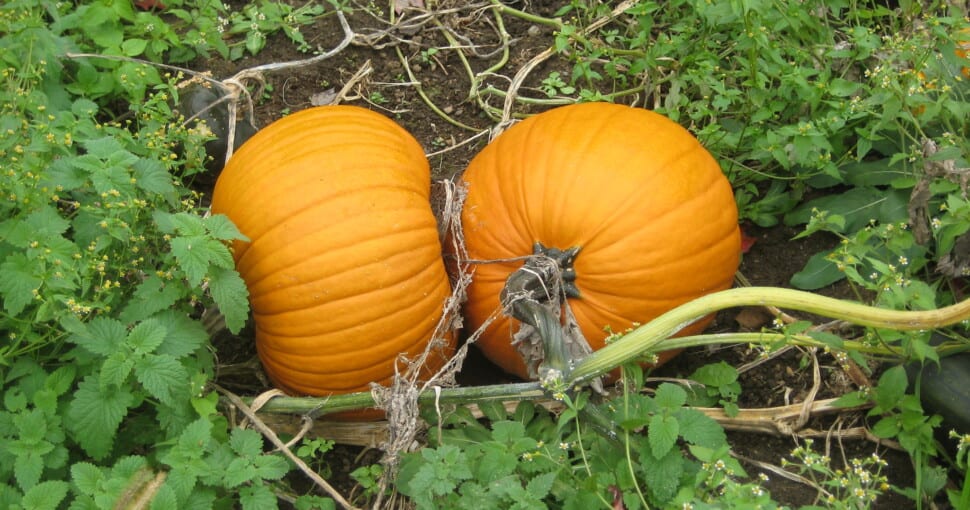Describing accurately what is meant when folks speak about pumpkins can be tricky. The Cucurbitaceae family that pumpkins belong to is vast, consisting of more than nine hundred species. There is no consensus regarding the definition of squash versus pumpkin.
For some, a trailing vine cucurbit is identified as a pumpkin, and a non-trailing vine cucurbit is a squash. This guideline is by no means conclusive. In most cases, the names pumpkin and squash are used interchangeably. If that is not confusing enough, pumpkin fruit is classified as a berry called a pepo in botanical terms. Really? Really.
Pumpkin varieties yield fruit that ranges in weight from nine pounds to seventy-five pounds. Then you get the giant pumpkins grown for competitions that can tip the scales at over two thousand pounds. Those are some BIG berries!!
Is there more uniformity when it comes to pumpkin leaves? Well, pumpkin leaves are not all identical, but there is a definite pattern that can indicate that you are looking at a pumpkin leaf. Pumpkin leaves may be round or palm-shaped. Mostly the leaves have three to five very distinct veins that start at the stem or base of the leaf and extend to the leaf edge. The veins divide the leaves into lobes.
Healthy pumpkin leaves are usually deep green to blue-green. Some varieties, like butternut squash, have silver patterns on the upper surface. Pumpkin leaves all have a rough, hairy texture, which is more distinct in some varieties. The leaf and stem texture of varieties like gem squash is more like bristles than hairs.
Healthy leaves can grow as big as ten inches across and are a healthy food source. Pumpkin leaves, fruit pulp, and seeds are all high in minerals and vitamins. Pumpkin seeds are also used to produce nutritious seed oil. All pumpkin leaves grow from long leaf stems called petioles. In a large number of varieties, the leaf stems are hollow.
Many plants with large round-shaped leaves could fit this description, so let’s look at a few plant types with leaves similar to pumpkins.
1. River Pumpkin
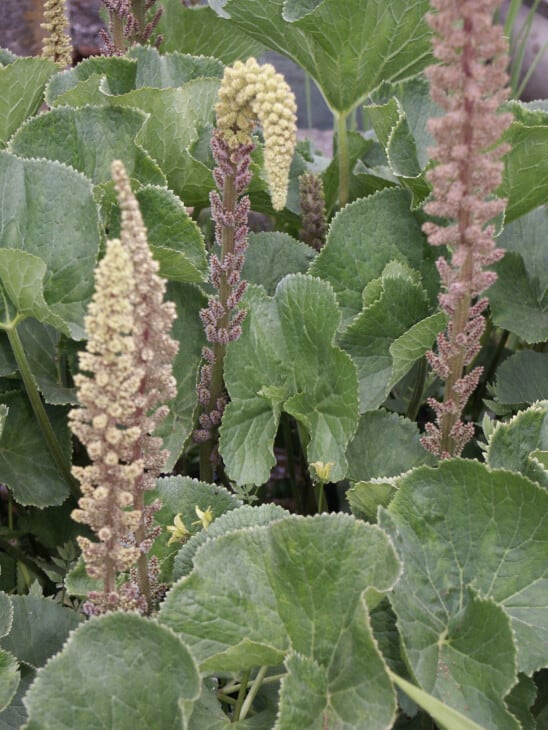
River pumpkins (Gunnera perpensa) are often called Madagascan Gunnera or Wild rhubarb. This is one of over sixty Gunnera varieties found throughout Africa and Madagascar. Gunnera is the only genus in the Gunneraceae plant family, though. Fossilized Gunnera pollen spores have been found that indicate these plants may have been around when dinosaurs roamed the earth.
River pumpkin plants are smaller than some other Gunnera varieties and grow to around three feet tall. The leaves are the same shape as pumpkin leaves with blue-green leaves. Like pumpkin, the river pumpkin leaves extend from a long petiole. The leaves of river pumpkins have distinct veins in a palmate-shaped pattern on each leaf.
River pumpkin leaves are covered with hairs on the upper and lower side of the leaves, making their leaves very similar to pumpkin leaves. Unlike pumpkin plants with trailing vine growth patterns, river pumpkin leaves grow from a central point. Their flowers also differ from true pumpkin plants. River pumpkin flowers are small and pink or reddish in color. The flowers grow from a long flower stem.
As the name indicates, river pumpkins grow along rivers, in wetlands, and in shallow water in marshy areas. These interesting plants have adaptations that allow them to thrive in these wetland conditions. River pumpkins do not have obvious fruit, but like pumpkins, the leaves and stems of river pumpkin plants are a popular food source.
2. Honeydew Melon
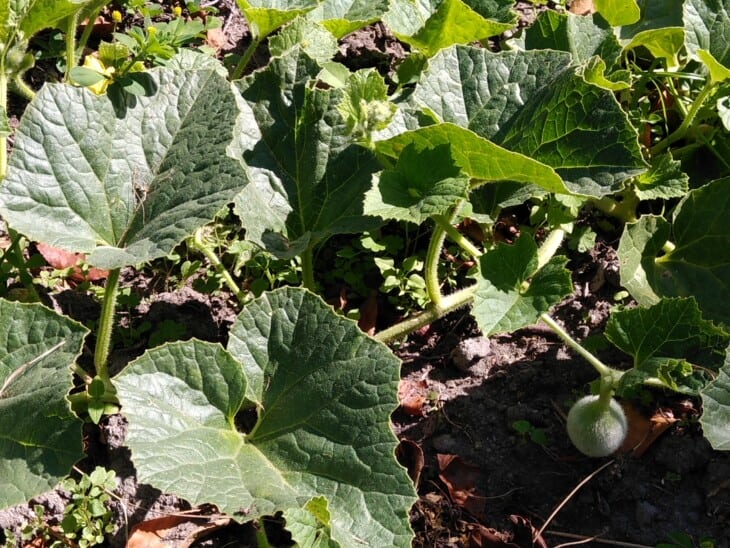
Honeydew melons belong to the Cucumis melo genus, one of more than ninety genera in the Cucurbitaceae plant family. These melons originated in the South of France, Spain, Northern Africa, and China. Honeydew melons can be found in gardens worldwide as long as summers are warm enough.
Like pumpkin plants, the honeydew melon grows on long vines, and the leaves are round to oval with a strong palmate vein pattern. The Honeydew melon plant looks similar to pumpkin plants, but the vines are slightly shorter, just below ten feet.
As with the pumpkin plant, the Honeydew melon has separate male and female flowers. The male flowers bloom first and have long flower stems. The female flowers are borne closer to the plant stem, and a tiny melon is visible below the female flower. As with pumpkins, honeydew melon leaves protect the fruit from the sun and keep the soil moist and cool.
Related: When Are (Honeydew) Melons In Season?
3. Chayote
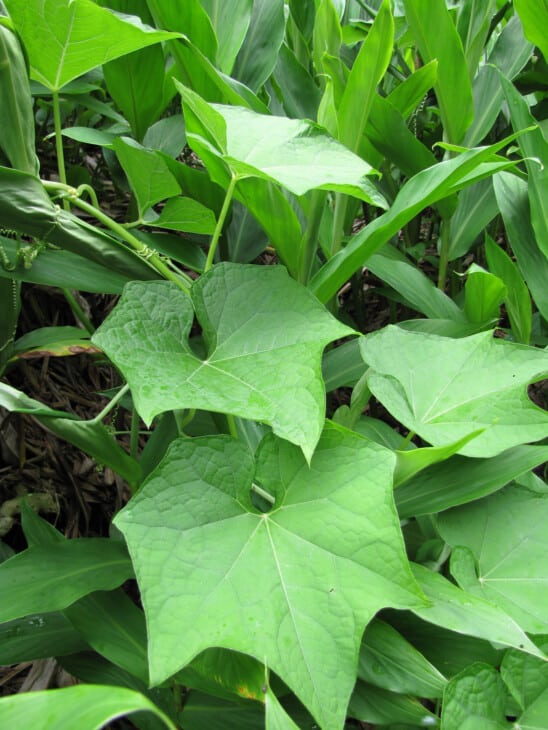
The chayote (Sechium edule) also goes by names like choko, chu-chu, mirliton, and vegetable pear. The chayote belongs to the Cucurbitaceae plant family. It hails from South and Central America, growing as a perennial plant in these warm climates. In temperate regions, chayote has an annual growth habit. Like the pumpkin plant, chayote has spread to almost every continent as a healthful food source.
Chayote leaves are a little smaller than pumpkin leaves and are light green in color. Chayote has the same round leaves with palmate vein divisions. The chayote also grows on a vine like a pumpkin plant, but the chayote climbs and trails upward rather than along the ground. In temperate areas, chayote grows as an annual plant.
The leaves and fruit of pumpkin plants are edible. Chayote plants are even more versatile. The stems, leaves, tubers, and pear-shaped fruit of the chayote are all edible. The tubers are eaten like a potato substitute, while the fruit is used in a cooked, raw, or even juiced form.
4. Cucuzza
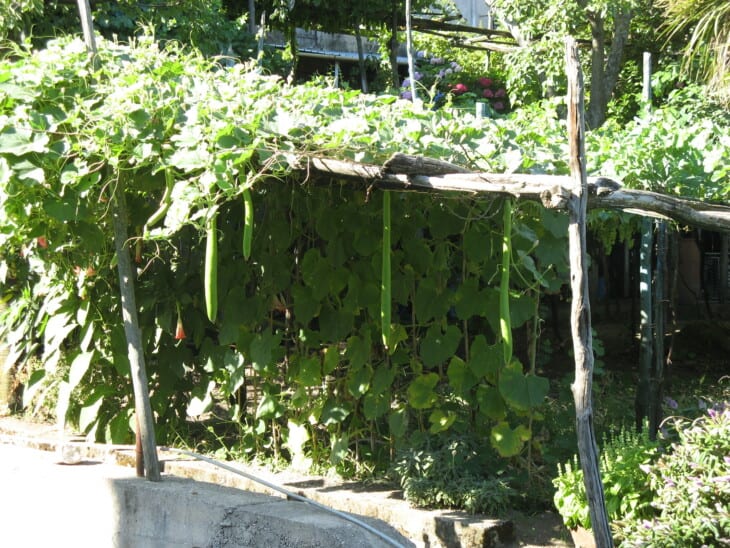
Cucuzza is a gourd in the Lagenaria genus with interesting names like Italian squash, the serpent of Sicily, suzza melon, and longissimi. Cucuzza is native to Africa and the South of Italy. It grows as an annual plant, even in tropical or subtropical regions. As with pumpkin, the cucuzza is fast-growing, and both plants are frost sensitive.
Cucuzza’s fleshy vines require support to trellis against or a large area of ground to spread across. Like pumpkin plants, cucuzza plants are big, with vines growing around twenty-five feet long and many side vines growing the same length. The cucuzza leaves are round to heart-shaped with the typical pumpkin leaf vein pattern.
Cucuzza flowers are similar in shape to pumpkin flowers but are white and bloom at night. The cucuzza fruit is very long, growing between one and three feet long. The flesh is white, and the skin of the young fruit is light green and smooth. As a green fruit, the cucuzza is eaten in the same way as other summer squash. If cucuzza is allowed to mature, the skin becomes hard with yellow or light brown color.
5. Pumpkin Tree
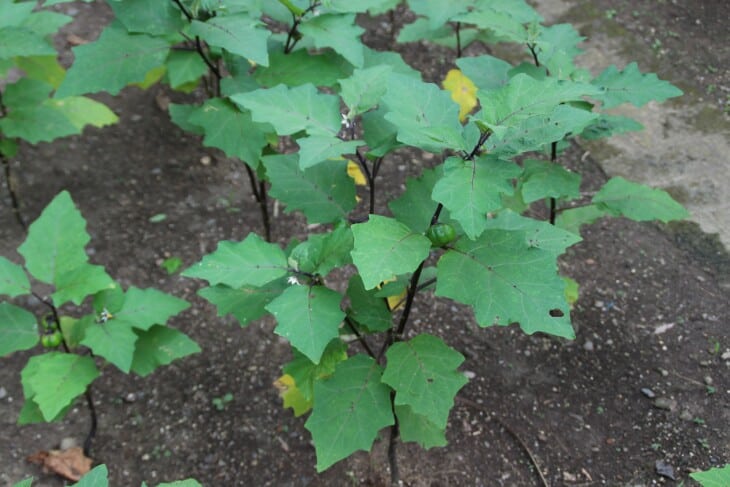
The pumpkin tree (Solanum integrifolium) is also called pumpkin on a stick, pumpkin bush, mock tomato, and ornamental eggplant. Despite the common name, the pumpkin tree is not a pumpkin but a nightshade. Pumpkin tree plants are native to Southeast Asia, with closely related varieties from Africa.
Pumpkin trees are grown as decorative plants in the West, but these ornamental eggplants are eaten in Asia and Africa. The large pumpkin tree leaves are more elongated than pumpkin leaves and are blue-green. The large size of the leaves and the pumpkin-shaped fruit sometimes mean that the two-foot tall plants are mistaken for pumpkins, though.
In many African countries, pumpkin tree leaves are eaten rather than brightly-colored eggplants, which are quite bitter. The pumpkin tree fruit ripens in late summer into early fall. This makes the fruit ideal as Thanksgiving decorations. The long stems are usually cut and stripped of leaves and thorny protrusions, leaving only the bright fruit. The fruit can last from two to four weeks in a decoration.

